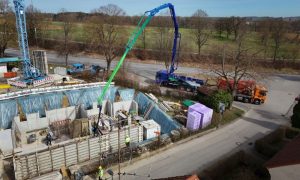Infrastructure digitalisation for a digitally-enabled world
Dr Jim Birdsall, project manager, Parsons identifies three key best practices for infrastructure digitalisation

Approved Content
Over the past 100 years, the infrastructure industry has embraced technology and business process innovations to improve infrastructure design, construction, and long-term maintenance.
From the introduction of hand-crank calculators to expedite the Golden Gate Bridge structural calculations, to the integration of finite element analysis models in the 1980s and 1990s to improve infrastructure design, to the deployment of maintenance management systems in the 2000s to achieve responsive maintenance management approaches, to the current integration of BIM and construction data aggregation platforms to achieve integrated construction focused technology platforms, the infrastructure industry has been a continually evolving business technology environment. Each of these innovations has brought the infrastructure industry closer to the final frontier of the infrastructure technology revolution—the complete digitalisation of infrastructure.
The digitalisation of infrastructure refers to the process of capturing, documenting, integrating, and analysing infrastructure digital data across the total life history of a given facility to maximise its long-term sustainability and minimise its total life-cycle cost.
This includes a wide range of business process data sets, including original design requirements, detailed design data, fabrication verification, construction inspection, commissioning confirmation, facility as-builts, facility operational history, preventative maintenance and inspections, corrective maintenance and retrofit, asset repurposing, and facility decommissioning. This range of data sets, when aggregated into and presented through an integrated digital platform, provides infrastructure owners with complete knowledge and the analytical tools to maximise the return on investment in their infrastructure.
The technology challenges facing today’s infrastructure owners are how to configure, deploy, integrate, and sustain digital infrastructure platforms.
Because Parsons has a wide range of experience assisting infrastructure owners in establishing digital infrastructure platforms, we have identified three key best practices for infrastructure digitalisation:
-
Technology deployment is more than just technology.
The successful configuration, deployment, and integration of a technology platform to advance infrastructure digitalisation requires more than just technology.
Digital infrastructure platforms require a three-pronged deployment approach: business consulting to identify the associated business processes, engineering consulting to select and integrate the required engineering analytics, and software development/integration to ensure the specific technology platform and tools are configured and deployed so that they directly fit into the owner’s and broader infrastructure stakeholders’ business processes and engineering needs. The successful delivery of all three of these aspects is required for successful technology deployment.
-
Technology platform stability, compatibility, and licensing is core.
The return on investment in infrastructure digitalisation is achieved through broad system integration and adoption and long-term usage within the facility operation and maintenance phases far beyond the infrastructure design and construction phases.
To achieve broad stakeholder adoption and long-term use, infrastructure digital platforms need to deliver stable, cross-platform-compatible, and clear licensing approaches. Such capabilities are presented in platforms that are committed to operational continuity for a minimum of 10-plus years with a future-proof service sustainment plan; platforms that foster and streamline cross-platform integration and data sharing; and platform licensing models that foster multi-stakeholder, enterprise-level usage.
-
Infrastructure owner leadership is essential.
Infrastructure owner leadership is essential to deploy and mandate the use of technology platforms for digitising infrastructure.
This key leadership ensures that the infrastructure owner can confirm that the broad range of infrastructure stakeholders are appropriately trained and that they promptly report into and effectively leverage the digital platform in the delivery of the broad range of services from concept design, into fabrication inspection, over to commissioning inspection, and on into operations and maintenance. Furthermore, infrastructure owner leadership helps to ensure that the technology platform has the stability and continuity inherent with infrastructure owner long-term platform operational support and that the platform data is clearly owned and controlled by the infrastructure owner.

Achieving Sustainability Through Infrastructure Digitalisation
Through the infrastructure digitalisation process, a facility owner establishes a combined and integrated total-life documented history of a given facility. This wealth of information empowers the facility owner with the tools to achieve operational and financial sustainability.
Focusing on our clients’ success, Parsons is assisting them in selecting, configuring, deploying, and integrating infrastructure digitalisation platforms . With some of the world’s top technical experts, we pride ourselves on being a true digitally enabled solutions provider. Through constant innovation, we’re always looking ahead to deliver the brightest possible future for our clients.
This article was authored by Dr Jim Birdsall, project manager, Parsons

















